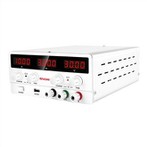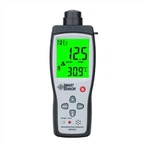In order to ensure the accuracy and safety of the measurement, the following inspections should be performed on the grounding resistance clamp meter before use:
1. Visual inspection: There should be no defects such as damage. In particular, the jaws should be closed tightly, and the iron core should be free of rust and dirt; 2. If it is a mechanical pointer type grounding resistance clamp meter, at this time The pointer should point to "0", otherwise it should be adjusted to "0"; 3. Estimate the magnitude of the measured current and select an appropriate gear. The principle of gear selection is: adjust the value greater than the measured value and close to the one One stop.
When measuring, open the jaws, clamp the wire to be measured into the jaws, close the jaws, and deflect the needle to read the measured current value. Before reading, the grounding resistance clamp meter should be as flat as possible (mechanical pointer type Ground resistance clamp meter), digital ground resistance clamp meter does not matter.
Pay attention when measuring
1. Gloves should be carried during the test (insulated gloves should be clean and dry wire gloves), and a guardian should be set up if necessary; 2. When shifting measurement is required, the wire should be withdrawn from the jaws first, and then the wire should be clamped to measure; 3. The voltage of the conductor under test cannot exceed the voltage level of the grounding resistance clamp meter; 4. It is forbidden to use the grounding resistance clamp meter for measurement with poor insulation and conductors; Be careful not to cause phase-to-phase short circuit and phase-to-ground short circuit; 6. It is not suitable to measure line current in high temperature environment, and it is not suitable to measure near strong magnetic field. The external magnetic field has a great influence on the measured value. If the measurement is carried out next to the high-load current equipment, it should be measured in another place to reduce the error short circuit caused by the magnetic field; 7. It is not suitable for measurement in wet places and thunderstorm weather, because the grounding resistance clamp meter must be directly measured by hand, and the running electrical equipment , the jaws, handles and hands of the measuring personnel must be kept clean and dry during the measurement; 8. The measurement error of the non-rated current by the grounding resistance clamp meter is large, and the working principle of the grounding resistance clamp meter determines the To use the grounding resistance clamp meter at the specified rate, in addition to measuring the sine wave current, the measurement of other waveform currents will produce errors. Generally, the waveform error of odd harmonics is larger than that of even spectral waves, especially the 3rd harmonic wave. The wave error becomes larger, and the half-wave rectified current is measured with a grounding resistance clamp meter, and the error is also larger; 9. After use, the gear should be placed in the high current gear, and when there is a watch cover, put it in the watch cover, and store it in a dry, dry place. A place free from dust, corrosive gas and vibration; 10. High-voltage current cannot be measured, the voltage of the circuit under test cannot exceed the rated voltage of the grounding resistance clamp meter, and the grounding resistance clamp meter cannot measure high-voltage electrical equipment.
The multimeter has the advantages of multi-purpose, wide range and convenient use. It is a commonly used tool in electrical measurement. It can be used to measure resistance, AC and DC voltage and DC current in electrical maintenance work. Some multimeters can also measure transistors. Main parameters and capacitance of capacitors, etc.






